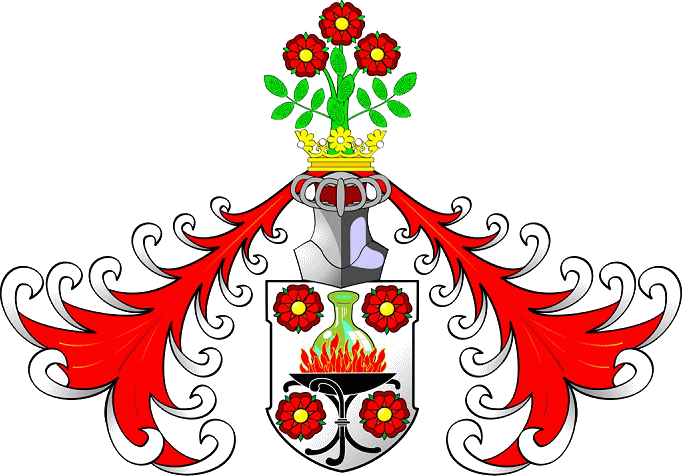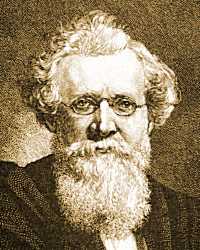

August Wilhelm von Hofmann (1818-1892)
German Chemist
The above is a copyrighted picture
reproduced here by permission. © 2009 by
Jochen Wilke.
In Silber auf eisernem Dreifuss in flammendem Kohlenbecken ein
natürlicher Siedekolben,
in den vier Schildesecken begleitet von je
einer goldenbesamten roten Rose.
Auf dem Helm mit rot-silbernen Decken,
3 golden-besamte rote Rosen an grünen Blätterstengeln.


Hofmann coined the term
aromatic
to denote a class of organic compounds with high carbon content,
which are now known to include a
phenyl ring
(like benzene).
The word aromatic is indeed first used (with a chemical meaning compatible
with the modern definition) in Hofmann's report
(1855)
on his own extension to an independent work (c. 1845) of
Jean-François Persoz (1805-1868)
on the oxidation of
cuminic acid
C10H12O2 or
(CH3)2CHC6H4COOH
This marked the discovery of what Hofmann himself called insolinic acid
C9H8O4 or
CH3C6H3(COOH)2
which is now known to consist of
one methyl group and
two carboxyl groups attached
to a phenyl ring.
The only other "bibasic" (i.e., diprotic
or dicarboxylic)
aromatic acids known to Hofmann at the time were the
phthalic acid
discovered in 1836 by Auguste Laurent
(1807-1853) and the isomer known as
terephthalic acid discovered
by Caillot, in 1847.
Caillot found it among the products of the action of dilute nitric acid on
oil of turpentine
whose French name (térébenthine)
provided him with the prefix he used to name the new compound.
Both isomers consist of two carboxyl groups attached to a phenyl ring, respectively in
the ortho and para
configurations,
and they share the formula
C8H6O4 or
C6H4(COOH)2.
The third isomeric configuration (meta)
dubbed isophthalic acid
wasn't known to Hofmann.

As shown at right, Hofmann attempted to match
those diacids to the related monoacids he knew.
He called all those compounds aromatic, without stressing that he
was thus coining a new name...
(Hofmann's formulas would actually represent
the number of atoms in two molecules if the symbol H stood
for two atoms of hydrogen; modern formulas are thus obtained by halving
the indices of C and O.)
His simple arithmetic didn't yield good predictions for the missing compounds (marked "?").
True understanding would have to wait until the discovery of the ring structure of
benzene by Kekulé, ten years later (1865).
Molecular Models :
Hofmann is commonly credited for being the first chemistry professor to use (primitive)
molecular models in public lectures.
The color coding he introduced for that purpose became the basis for the scheme used in most
modern sets,
which was tentatively standardized by the Institute of Physics in 1947:
carbon=black, hydrogen=white,
oxygen=red, halogens=greenish, nitrogen=blue, sulfur=yellow, phosphorus=purple...
Institute of Physics,
"The standardization of crystal structure models"
Journal of Scientific Instruments, Vol. 24, 9 pp. 249-250 (1947).
The British Museum has several molecular models that had been used
by earlier chemists, including John Dalton (1766-1844).
The use of polyhedral models predates the theoretical
framework which made them legitimate for chemistry:
Johannes Kepler (1571-1630)
used them to speculate about the microscopic structure of crystals as early as 1611...
Wikipedia
|
Hofmann elimination
|
Hofmann rearrangement
|
Hofmann-Löffler
reaction
|
Bibliography
on Molecular Models (NBS, 1960)









